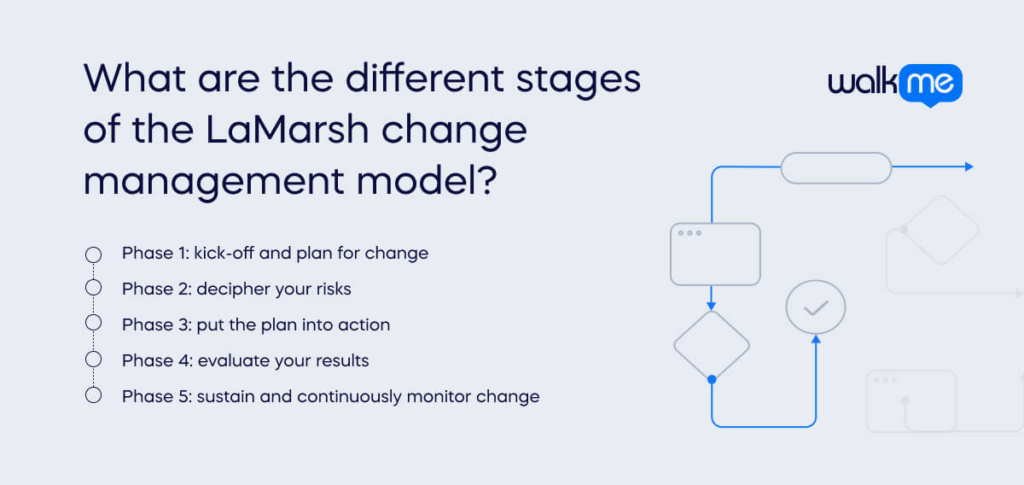The success of any change initiative hinges on user adoption; without it, introducing new technology or solutions loses its value.
Achieving this adoption requires organizations to devise a strategy that acknowledges and addresses resistance to change or the onset of change fatigue.
Gartner highlights that when managers foster a psychologically safe environment, change fatigue can significantly decrease—up to 46%.
This is where the LaMarsh Change Management Model comes into play. It offers a structured approach for leaders and project managers to identify, confront, and surmount the obstacles to effective change implementation.
In this article, we will examine the LaMarsh change management model, its different stages, what it means for change management, and, with practical examples, how you can implement it within your organization.
What is the LaMarsh change management model?
The LaMarsh change management model adopts a process-oriented strategy, distinguishing itself from more people-centric methodologies such as Maurer’s 3 Levels of Resistance and Change. At its core, it emphasizes the importance of a risk management framework, offering strategies for risk mitigation throughout the change process.
Additionally, LaMarsh aids in setting priorities by pinpointing the most critical areas for change implementation.
It functions cyclically and iteratively, similar to the PDCA cycle or the Kaizen Change Management Model, and it is propelled by leadership initiatives.
The model considers the employees’ responses to change as part of its risk assessment efforts. Addressing the risks associated with accepting and implementing change early in the process facilitates a smoother organizational transition.
Central to the LaMarsh model is the focus on deliberate changes to foster success. It identifies key areas poised for significant benefit from the change and ensures comprehensive understanding among all involved employees regarding its purpose and execution.
What are the different stages of the LaMarsh change management model?

The LaMarsh change management model presents a systematic approach to managing change, detailing five essential phases that an organization should follow:
Phase 1: kick-off and plan for change
The LaMarsh Change Management Model kicks off with the initiation phase, which includes traditional strategic planning and direction setting, as well as detailed program and project planning. This foundational stage involves deciding on the market approach, assessing necessary resources, and outlining the actions needed to reach the set objectives.
This stage might also involve putting together a change management team.
The LaMarsh Model outlines four essential roles within the framework of change management: the Change Sponsor, who is a leading figure at the helm; the Change Agent, a member of the team responsible for enacting the change; the Target, who refers to the employees affected by the change; and the Advocate, an individual with the skills to influence others effectively.
Each role carries specific duties, and their cooperation is crucial for successfully executing change management strategies.
Although this phase might initially mirror a linear, single-iteration process, it is inherently designed to be adaptable, allowing for ongoing adjustments to ensure goal attainment despite potential disruptions.
Phase 2: decipher your risks
Identifying risks is the second pivotal step in the LaMarsh model. It focuses on recognizing potential barriers that could hinder the change initiative’s success. This stage is critical for preemptively addressing challenges by developing risk mitigation plans.
By pinpointing risks early, organizations can formulate contingency strategies and allocate resources effectively, significantly boosting the likelihood of successful change. Techniques such as risk assessments or employee focus groups might be employed to uncover potential threats to the change process.
Phase 3: put the plan into action
The implementation phase is where the previously set direction and identified risks are tackled head-on, with an expansion of the necessary activities to achieve the desired outcomes.
The essence of this phase lies in the meticulous execution of the plan, ensuring no vital activities are overlooked that could impede success. It involves close monitoring of metrics and making necessary adjustments to activities to align with the expected results.
Phase 4: evaluate your results
This phase evaluates whether the expected results have been achieved and addresses any discrepancies. It involves thoroughly analyzing outcomes against goals and devising strategies to mitigate any identified gaps.
Phase 5: sustain and continuously monitor change
The final phase of the LaMarsh Change Management Model emphasizes embedding the changes into the organizational culture and operations to ensure long-term benefits.
Sustaining outcomes is crucial for realizing the full benefits of the change initiative over time and lays the groundwork for future improvements. Leadership is vital in this phase, ensuring that changes are fully integrated into the organizational fabric and operations.
Practical LaMarsh change management model applications
Here are some examples of how companies used a methodological approach taken to change like the La Marsh change management model suggests, which also considered their employees:
PwC
The initial phase of the LaMarsh Change Management Model encourages organizations to assess the potential impact of workforce transformation on individuals, urging reflection on the personal experiences of those changing. A positive employee experience enhances the organization’s reputation and provides the mental support necessary for employees to perform their roles confidently and clearly.
For example, PwC has developed a strategy that promotes voluntary skill development over compulsory participation.
This approach grants all employees access to a digital fitness app, allowing them to engage in self-paced courses. Additionally, PwC enriches this learning environment with interactive ‘learning bursts,’ virtual community events reminiscent of game shows, and a hands-on training initiative known as the digital academy.
The firm further encourages innovation through a crowdsourcing platform, where individuals can share their developed bots and apps, earning points for their utilization by others.
DBS
DBS strongly emphasized employee engagement as a cornerstone of its transformational change, even before the official implementation began. It engaged with its employees, soliciting input on what was necessary to propel the organization forward.
This collaborative approach led to the establishment of their PRIDE! Values: Purpose-driven, Relationship-led, Innovative, Decisive, and Everything fun.
These values and behaviors are intricately woven into all their people programs and processes. This includes performance appraisals, where employees are evaluated not just on the outcomes but also on the approach during recruitment to ensure candidates align with the organizational culture, in promotions, and throughout various leadership development programs.
DBS aimed to empower its employees by trusting them with greater decision-making autonomy. Previously managed by senior vice presidents and above, decisions related to performance and compensation are now entrusted to line managers. Customer service representatives can decide on matters involving amounts up to $200.
The organization fosters an experimental mindset among its workforce, encouraging them to try new things without fearing making preventable mistakes. They have created a supportive environment where individuals feel comfortable voicing their opinions and taking risks.
For instance, in meetings, everyone is allowed to contribute, with senior employees encouraged to speak last to promote a diversity of perspectives. Employees are also urged to challenge prevailing views by playing devil’s advocate, cultivating a culture that values differing opinions.
What does LaMarsh mean for change management?
The LaMarsh Change Management Model distinguishes itself as a thorough framework that steers organizations through the intricacies of change management. It underscores the necessity of a systematic approach, recognizing change not as a one-time event but as a continuous journey.
The model advocates for organizational agility, allowing you to navigate shifting landscapes. A vital element of this model is the active involvement and engagement of employees and stakeholders, ensuring their perspectives, concerns, and feedback are integral to the change process.
Change leadership is identified as a pivotal force in initiating and maintaining momentum for change, requiring commitment from leaders across all organizational tiers to endorse and lead the change efforts.
Unlike some models that may focus narrowly on the execution phase, the LaMarsh Model significantly emphasizes both the implementation and the prolonged sustainability of change.
It introduces mechanisms for reinforcement and evaluation during the sustain and continuously monitor stage, aiming to integrate the change deeply into the organization’s culture and operational routines for enduring impact.
Furthermore, the LaMarsh Model highlights the criticality of defining clear roles and building organizational change management capabilities. This approach ensures that all participants in the change process are clear about their roles and possess the necessary skills to fulfill them effectively.
The LaMarsh Model is primarily presented as a versatile starting point for organizations embarking on the change journey due to its adaptability to various organizational structures and industry sectors.
Its flexibility enables customization to meet each organization’s specific demands and challenges, making it suitable for various change management scenarios.
Tips to implement the LaMarsh change management model within your company

While the LaMarsh change management model does offer a step-by-step guide on how to execute it within your organization, here are some valuable tips that can help you when adopting it for your change management efforts:
Perform a thorough change analysis at the start
Before embarking on organizational change, an organization must conduct an in-depth change analysis. This involves a willingness to engage in self-examination, both honestly and critically.
Collecting data, soliciting feedback from various organizational levels, and being receptive to potentially uncomfortable truths are critical components of this process.
Early identification of risks and challenges enables organizations to devise proactive mitigation strategies, helping avoid obstacles and disruptions during the transformation.
A foundational step is mapping the organization’s current state to discern what is effective and what is not. This information is vital in communicating with employees most impacted by the change and clarifying the reasons behind necessary transitions.
Keep open communication in mind
Open communication is essential for organizational change to be impactful. This starts with engaging all levels of management, as their involvement significantly influences employee engagement. Everyone from executives to front-line managers should participate in change discussions, fostering a culture of openness and trust. The organization promotes a unified approach to change by ensuring every voice is heard.
Ensure that employees are engaged in the change process
Facilitating a thorough review of the intended outcomes of the change is essential. Holding one-on-one or group meetings encourages an employee feedback loop in the change process. These discussions allow employees to voice their thoughts and feelings, which is crucial for gauging collective sentiment toward the change.
Inquiring whether proposed changes align with departmental goals and responsibilities can further enhance employee engagement, often indicative of the success of the organizational change.
Empowering stakeholders to actively engage in the business transformation process through focus groups, task forces, or advisory boards empowers employees. Their involvement allows them to take ownership of their roles in the transformation, potentially leading to increased motivation and job satisfaction.
Adapt your existing strategy based on feedback
Organizational change management demands adaptability. After engaging in discussions and gathering diverse feedback, organizations should be ready to iterate on their strategy.
Sharing outcomes and next steps after these adjustments demonstrates respect for employee input and reinforces engagement by showing that their contributions lead to actionable changes.
Understand the role effective leadership plays
Influential leaders are the catalysts for transformative change, providing the guidance, inspiration, and drive necessary to navigate organizations toward their objectives.
They articulate a clear, motivating vision for the future, ensure transparent communication, and build strong interpersonal relationships with their team members. By fostering a supportive and inclusive work environment, empathetic leaders lay the groundwork for a collaborative and productive team culture.
Track and utilize change management metrics
Consistent monitoring and analysis of change management metrics give organizations and their leaders a deeper understanding of the impact of change.
These metrics offer insights into behavioral changes or adjustments in internal processes, enabling effective communication of the change’s benefits to stakeholders. Leveraging data for informed decision-making is crucial for refining change management strategies and ensuring their success.
Proper tracking of change management metrics is essential for demonstrating the organization’s current standing and deriving insights into necessary adjustments moving forward.
Relying on data rather than guesswork ensures that decisions are made on a solid foundation, maximizing the effectiveness of change initiatives.
By connecting metrics to team performance and educating team members on the data collection process, organizations empower everyone involved to engage with and contribute to meaningful change.
The future of the LaMarsh change management model
The LaMarsh Change Management Model provides a holistic and robust framework for navigating organizational development. It highlights key aspects such as risk management, long-term sustainability, active stakeholder participation, and adaptability.
Adopting the LaMarsh Model can significantly aid leaders and project managers in effecting enduring and positive organizational changes.
By leveraging this model, you position yourself to confront and manage the complexities of change management more effectively, fostering an environment where change is accepted and embraced, paving the way for a more prosperous future for your organization.
However, it’s crucial to customize the model to align with your organization’s specific requirements and circumstances and the particular change effort at hand. This ensures the model’s applicability and maximizes its potential to address the distinct challenges and opportunities presented by the change initiative.

